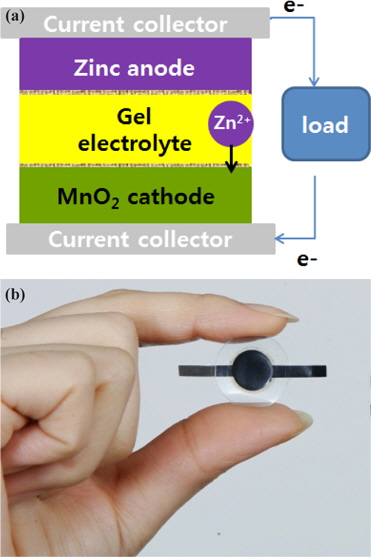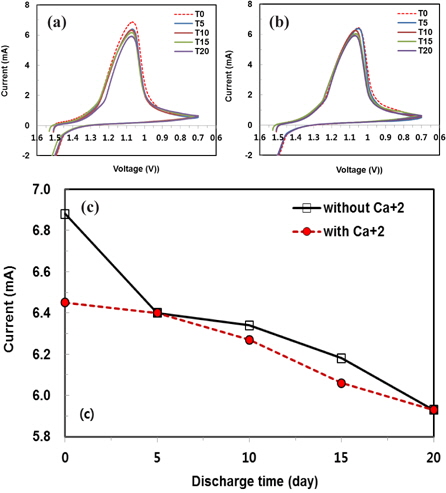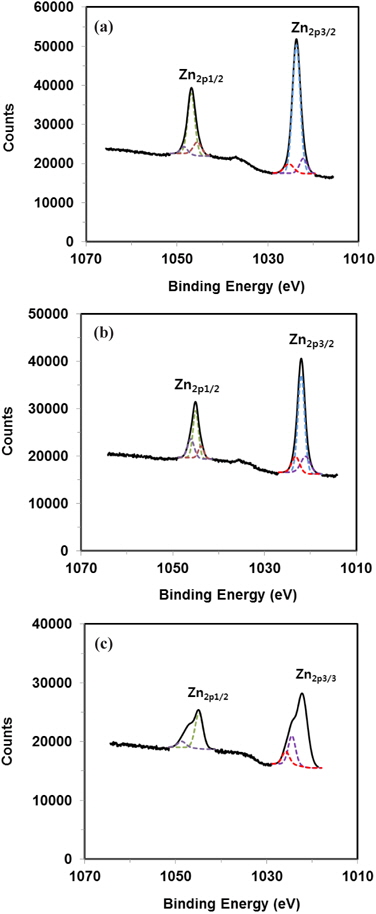



Film type manganese battery has been developed with a breakthrough platform technology which enables the low-cost mass production of thin and flexible energy cells [1-5]. Film type manganese battery is produced by using a simple mass-printing technology and proprietary inks. Such innovative technology enables the printing of caseless, thin, flexible, and environmentfriendly energy cells on a polymer film type substrate. Since the film type manganese batteries are thin and flexible, a large variety of applications could be tailored as follows: cosmetics, smart cards, sensors, greeting cards or semi-active radio-frequency identifications (RFIDs). The zinc electrode is a negative (anode) active-material, which is very suitable for use in aqueous electrolytes due to its high energy per unit volume and high hydrogen over potential. The electrochemical reaction of the zinc electrode in a battery proceeds via the following dissolution-precipitation reaction [6]:
An independent chemical decomposition of zincates may also occur to form a passive film of zinc oxide, i.e.
This instability becomes apparent in the internal pressure, which is often accompanied by self-discharging due to cell distortion. Gas could form in all of these types of batteries due to the corrosion of zinc. Zinc in the battery becomes corroded into the electrolyte, while the battery is being used. This corrosion can cause electrolysis, with the generation of hydrogen gas in the canister. The build-up of hydrogen gas can cause the battery to leak, which limits the ability of the battery to function.
For a long time, mercury has been employed in the alkaline manganese batteries, since it is the most useful additive to the zinc anode material for suppressing hydrogen gas evolution that is caused by self-discharge reactions [7-10]. Due to environmental concerns, however, a much recent research has been carried out to diminish the content of mercury in the zinc powder. Zinc has a more negative redox potential than hydrogen and thus promotes hydrogen gas evolution. This condition makes it difficult for the batteries to be sealed. Consequently, a considerable number of attempts have been made to substitute mercury with other additives [11-15]. Yamakawa et al reported that adding multiple components, such as viz., indium, lead, bismuth, and tin, to zinc particles is effective in suppressing hydrogen gas evolution [13]. Miura et al reported that indium, bismuth, and calcium with an organic inhibitor also suppress hydrogen gas evolution [14]. Shao et al reported that the cooperative effect of calcium ion and tartrate ion on the corrosion inhibition of pure aluminum in an alkaline solution was investigated by hydrogen collection, electrochemical methods, and X-ray photoelectron spectra (XPS) [15].
In this work, we suggested a chemical equation and proved that calcium hydroxide in the electrolyte acted as a corrosion inhibitor in the film-type manganese batteries.
Binder solution was prepared by using 60 wt.% polytetrafluoroethylene (PTFE) emulsion mixed with 2.6 wt.% carboxyl methyl cellulose solutions. The 60 wt.% of MnO2 powder with 3wt% of acetylene black and 37 wt.% of binder solution were mixed by planetary mixer for 5 h. A homogenized slurry was obtained, and the slurry was coated on 50 μm thick polyester film printed with carbon ink which has been used as a current collector. The resulting product was dried in an oven at 150℃ for 40minutes, followed by placing it in a vacuum drying oven at 150℃ for 1 hr. The dried mixture was pressed by a roll press and was cut into small pieces of 2.2 × 3.35 cm2 to use as positive plates. The negative electrode was prepared by mixing zinc powder (Duksan Co.), Acetylene black, and binder solution
Zinc chloride solution was obtained by dissolving 90 g of ZnCl2 in 150 ml of distilled water. To make Ca added electrolyte, 0.1 wt% of Ca(OH)2 solution was prepared with Ca(OH)2 (Daejung Chemical) dissolved in distilled water. After aging for 2 days, it was separated into upper solution and saturated Ca(OH)2 solution. The 48 wt% of ZnCl2 solution was prepared by mixing ZnCl2 and 0.1% Ca(OH)2 solution. The 165 g of NH4Cl was dissolved in the solution and was mixed with polyvinyl alcohol (Sigma-Aldrich), surfactant, and inhibitor by planetary mixer for 5 h. Gel electrolyte used in this study was prepared by melting polyethylene oxide (Sigma-Aldrich) in liquid electrolyte. The gel electrolyte was coated over the positive plate, and then the separator (a non-woven polypropylene fabric) was positioned on the gel electrolyte. The negative plate was also positioned on the separator, and the stacked electrodes were covered with a heat confusable laminated film (pouch), which constituted the exterior material for the cell. The cell was sealed under vacuum condition to make a film-like flexible lithium battery. The total surface area of the cell was about 14.1 cm2 . The thickest part of the cell was not more than 0.48 mm, and the average thickness was 0.45 mm. The electrochemical measurement was performed using a Potentiostat/Galvanostat (EG&G273A) in a two-electrode cell. The working electrode was Zinc Anode, and counter and reference was MnO2 cathode electrode. The measurement sample was prepared by sandwiching the gel polymer electrolyte with polypropylene fabric separator between two electrodes.
The X-ray photoelectron spectra were recorded using VG MICROLAB MK I system with Al k X-ray source (hν = 1,486.6 eV), at a base a pressure of ~10-10 mbar in the analysis chamber. The binding energy (EB) of the XPS spectrum was calibrated using C line at 284.6 eV, arising due to hydrocarbon adsorption on sample surface from the laboratory environment [16]. XPS spectra were recorded for as-deposited Zn p3/2 film and after argon ion etching at the rate of ~40 Å/min for 3 min, in order to remove the surface oxide layer. Prior to analyses, the specimens were kept immersed in 1 M ZnCl2 and saturated Ca(OH)2 for 24 hr. Then, the specimens were rinsed in deionized water and dried in air
The amount of hydrogen gas evolution in these testing cells was evaluated by a volumetric method. After discharging them with a constant load of 3.9 V up to a capacity of about 20%, a part of the negative electrode side was opened. Then, the testing cells were placed on the bottom of a glass cell of 50 cm3 . The apparatus was immersed in a bath with constant temperature of 45℃. The structure of the experimental cell (Fig. 1(a)) and real cell (Fig. 1(b)) for the polymer gel electrolyte based film-type manganese battery are shown in Fig. 1
Figure 2 shows the reduction ratio of the each potential current density curve from the cyclic voltammogram of film type manganese battery used with 8 wt.% of polyethylene oxide gel electrolyte at a sweep rate of 0.01 mVs-1. These slopes represent the speed of reduction ratio in zinc corrosion reaction. The potential was controlled from 0.7 to 1.51 V. One distinguishable anodic peak emerged at around 1.05 V during discharge. The slopes of solid line in Fig. 2 were 0.96, 0.12, 0.32, and 0.5 every 5 days without the insertion of Ca(OH)2, and the slopes of dotted line were o.1, 0.26, 0.42, and 0.26 with the insertion of the Ca(OH)2. The average values of overall slopes for 20 days were 0.47 without the insertion of the Ca(OH)2 and 0.26 with the Ca(OH)2. This phenomenon shows that the Ca2+ ion acts as an inhibitor in the corrosion reaction of zinc electrode. This anodic peak should be considered as the insertion of Zn2+ ions into the solid MnO2 matrix. The oxidation peak-current difference of MnO2 electrode in aqueous ZnCl2 electrolyte including binder were 0.95 mA and 0.52 mA, according to the storage times with and without Ca2+ ion, respectively. This may suggest that the Zn2+ insertion process is irreversible, and it is a good inhibitor for preventing the corrosion of zinc electrode. The surface of zinc is tightly adsorbed by OH- , with oxygen atom combined with calcium and hydrogen atoms exposed to solution. It is difficult for calcium ions with positive charges to get through the OH- adsorbed layer to become adsorbed onto the zinc surface. The positive charge of Ca2+ is neutralized, which makes it easier to get through the OH- layer; also, it can increase the solubility of Ca(OH)2 in KOH solution. Therefore, the joint addition of calcium ions produces inhibition effect for the corrosion in the alkaline solution.
Figure 3 shows the expanded runs of the strongest XPS core lines Zn (2p doublet). Figure 3 presents the doublet lines of Zn corresponding to 2p3/2 and 2p1/2 at 1,022.1 and 1,045.2 eV, respectively. The Zn 2p3/2 line shown separately in Fig. 3 has been shifted by +0.4 eV from the reported average binding energy position of 1,021.7 eV for elemental zinc [17,18].
Figure 4 shows that the volume of H2 evolved from zinc electrode in electrolyte solution were 1.91, 2.31, 2.93, 3.36, 3.50, 3.66, and 4.15 cc/g-zinc with Ca2+ ion and 1.72, 2.45, 3.22, 3.60, 3.81, 4.21, and 4.81 cc/g-zinc without Ca2+ ion, along with 5, 7, 10, 12, 14, 17, and 20 days. The amount of H2 gas generation in the presence of Ca2+ ion was reduced from 4.81 to 4.15 cc/g-zinc (14%), and the corrosion of zinc electrode in the electrolyte was strongly inhibited. The chemical reaction mechanism of Ca2+ ion is suggested as follows:
The inhibition occurs due to the adsorption of the inhibitor (Ca2+ ion) onto the surface of zinc electrode.
A manganese dioxide (MnO2) layer and zinc (Zn) layer are used in this study as the cathode and the anode to develop filmtype manganese battery. We found the swelling mechanism and/ or control using Ca(OH)2 as an inhibitor in the electrolyte of film-type manganese battery to prevent the formation of H2 gas. The amount of H2 gas generation in the presence of Ca2+ ion was reduced from 4.81 to 4.15 cc/g-zinc (14%), and the corrosion of zinc electrode in the electrolyte was strongly inhibited as time passed. These phenomena are due to the adsorption of the inhibitor (Ca2+ ion) onto the surface of zinc electrode.






